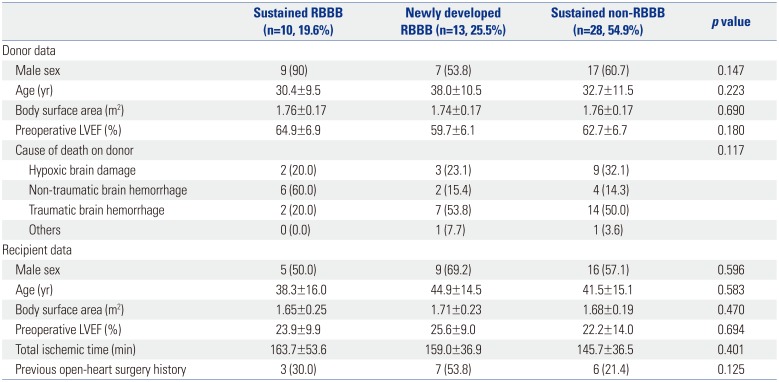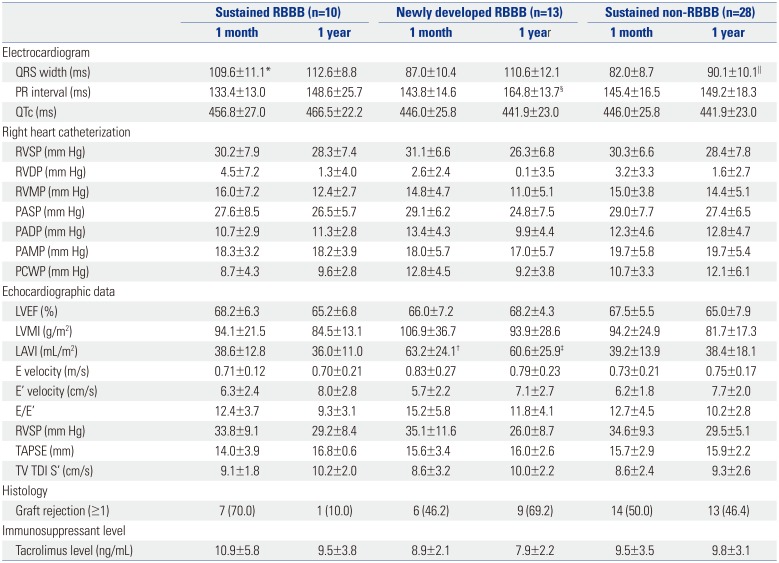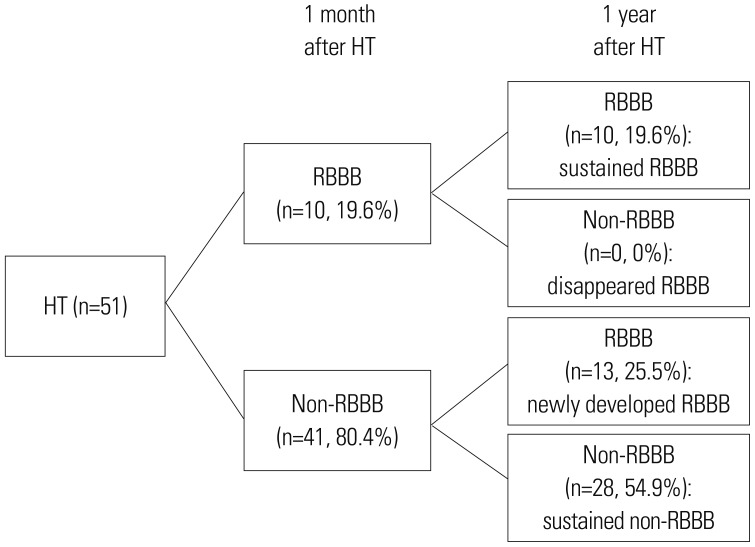1. Sandhu JS, Curtiss EI, Follansbee WP, Zerbe TR, Kormos RL. The scalar electrocardiogram of the orthotopic heart transplant recipient. Am Heart J. 1990; 119:917–923. PMID:
2321511.

2. Gao SZ, Hunt SA, Wiederhold V, Schroeder JS. Characteristics of serial electrocardiograms in heart transplant recipients. Am Heart J. 1991; 122(3 Pt 1):771–774. PMID:
1877454.

3. Leonelli FM, Pacifico A, Young JB. Frequency and significance of conduction defects early after orthotopic heart transplantation. Am J Cardiol. 1994; 73:175–179. PMID:
8296739.

4. Jessen ME, Olivari MT, Wait MA, Meyer DM, Yancey CW Jr, Ring WS. Frequency and significance of right bundle branch block after cardiac transplantation. Am J Cardiol. 1994; 73:1009–1011. PMID:
8184837.

5. Golshayan D, Seydoux C, Berguer DG, Stumpe F, Hurni M, Ruchat P, et al. Incidence and prognostic value of electrocardiographic abnormalities after heart transplantation. Clin Cardiol. 1998; 21:680–684. PMID:
9755386.

6. Osa A, Almenar L, Arnau MA, Martínez-Dolz L, Rueda J, Morillas P, et al. Is the prognosis poorer in heart transplanted patients who develop a right bundle branch block? J Heart Lung Transplant. 2000; 19:207–214. PMID:
10703698.

7. Foerster A. The conduction system in human cardiac allografts. A histological and immunopathological study. Pathol Res Pract. 1992; 188:783–790. PMID:
1437842.
8. Calzolari V, Angelini A, Basso C, Livi U, Rossi L, Thiene G. Histologic findings in the conduction system after cardiac transplantation and correlation with electrocardiographic findings. Am J Cardiol. 1999; 84:756–759. PMID:
10498155.

9. Chan JB, Levi DS, Lai CK, Alejos JC, Fishbein MC. Cellular rejection of the conduction system after orthotopic heart transplantation for congenital atrioventricular block. J Heart Lung Transplant. 2006; 25:1371–1375. PMID:
17097504.

10. Aro AL, Anttonen O, Kerola T, Junttila MJ, Tikkanen JT, Rissanen HA, et al. Prognostic significance of prolonged PR interval in the general population. Eur Heart J. 2014; 35:123–129. PMID:
23677846.

11. Stewart S, Winters GL, Fishbein MC, Tazelaar HD, Kobashigawa J, Abrams J, et al. Revision of the 1990 working formulation for the standardization of nomenclature in the diagnosis of heart rejection. J Heart Lung Transplant. 2005; 24:1710–1720. PMID:
16297770.

12. Lang RM, Bierig M, Devereux RB, Flachskampf FA, Foster E, Pellikka PA, et al. Recommendations for chamber quantification: a report from the American Society of Echocardiography's Guidelines and Standards Committee and the Chamber Quantification Writing Group, developed in conjunction with the European Association of Echocardiography, a branch of the European Society of Cardiology. J Am Soc Echocardiogr. 2005; 18:1440–1463. PMID:
16376782.

13. Marcus GM, Hoang KL, Hunt SA, Chun SH, Lee BK. Prevalence, patterns of development, and prognosis of right bundle branch block in heart transplant recipients. Am J Cardiol. 2006; 98:1288–1290. PMID:
17056348.

14. Villa AE, de Marchena EJ, Myerburg RJ, Castellanos A. Comparisons of paired orthotopic cardiac transplant donor and recipient electrocardiograms. Am Heart J. 1994; 127:70–74. PMID:
8273758.

15. Ferretto S, Tafciu E, Giuliani I, Feltrin G, Bottio T, Gambino A, et al. Interventricular conduction disorders after orthotopic heart transplantation: risk factors and clinical relevance. Ann Noninvasive Electrocardiol. 2017; 22:e12402.

16. Martí S, Almenar L, Luis Vicente J, Torregrosa S, Roldán I, Moreno MT, et al. [Which variables predict the appearance of right bundle-branch block and its course after heart transplantation?]. Rev Esp Cardiol. 1996; 49:328–333. PMID:
8744386.
17. Thalen HJTh, Meere CC. Fundamentals of cardiac pacing. 1st ed. The Hague: Springer;1979. p. 44.
18. Butman SM, Phibbs B, Wild J, Copeland JG. One heart, two bodies: insight from the transplanted heart and its new electrocardiogram. Am J Cardiol. 1990; 66:632–635. PMID:
2392984.

19. Alderman EL, Wexler L. Angiographic implications of cardiac transplantation. Am J Cardiol. 1989; 64:16E–21E. PMID:
2741809.

20. Leonelli FM, Dunn JK, Young JB, Pacifico A. Natural history, determinants, and clinical relevance of conduction abnormalities following orthotopic heart transplantation. Am J Cardiol. 1996; 77:47–51. PMID:
8540456.

21. Brunner-La Rocca HP, Sütsch G, Schneider J, Follath F, Kiowski W. Natural course of moderate cardiac allograft rejection (International Society for Heart Transplantation grade 2) early and late after transplantation. Circulation. 1996; 94:1334–1338. PMID:
8822989.

22. Kwok CS, Rashid M, Beynon R, Barker D, Patwala A, Morley-Davies A, et al. Prolonged PR interval, first-degree heart block and adverse cardiovascular outcomes: a systematic review and meta-analysis. Heart. 2016; 102:672–680. PMID:
26879241.

23. Payne ME, Murray KD, Watson KM, Galbraith TA, Horwanitz EP, Starling RC, et al. Permanent pacing in heart transplant recipients: underlying causes and long-term results. J Heart Lung Transplant. 1991; 10(5 Pt 1):738–742. PMID:
1958680.
24. Collins KK, Thiagarajan RR, Chin C, Dubin AM, Van Hare GF, Robbins RC, et al. Atrial tachyarrhythmias and permanent pacing after pediatric heart transplantation. J Heart Lung Transplant. 2003; 22:1126–1133. PMID:
14550822.

25. Cannon BC, Denfield SW, Friedman RA, Fenrich AL, Dreyer WJ, Towbin JA, et al. Late pacemaker requirement after pediatric orthotopic heart transplantation may predict the presence of transplant coronary artery disease. J Heart Lung Transplant. 2004; 23:67–71. PMID:
14734129.

26. Grutter G, Alfieri S, Calcagni G, Castelluzzo MA, Silvetti MS, Parisi F, et al. Paroxysmal atrioventricular block after heart transplantation in children: an early sign of rejection? Pediatr Transplant. 2016; 20:1164–1167. PMID:
27743416.

27. Weckbach LT, Maurer U, Schramm R, Huber BC, Lackermair K, Weiss M, et al. Lower frequency routine surveillance endomyocardial biopsies after heart transplantation. PLoS One. 2017; 12:e0182880. PMID:
28841655.









 PDF
PDF ePub
ePub Citation
Citation Print
Print




 XML Download
XML Download